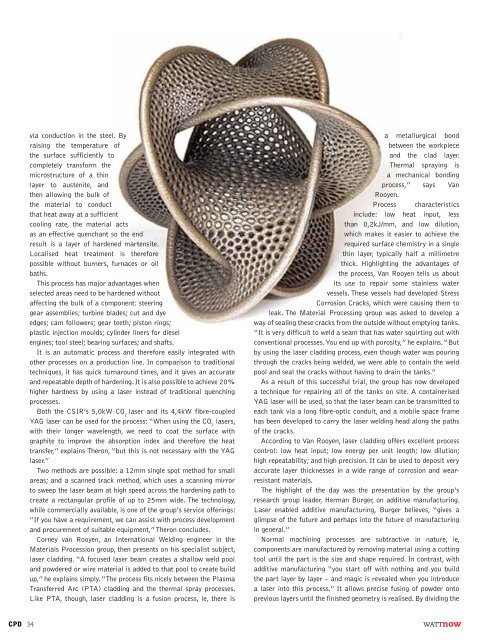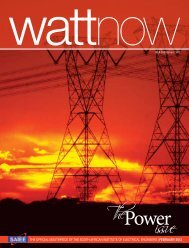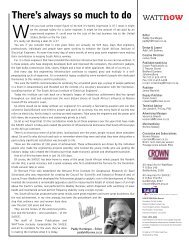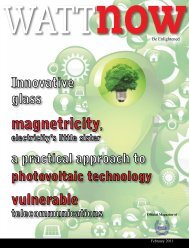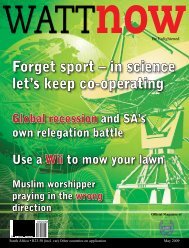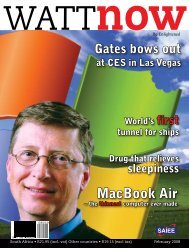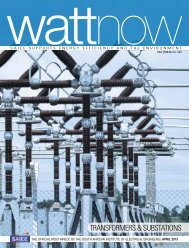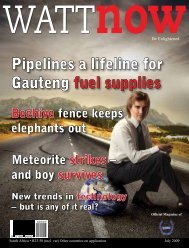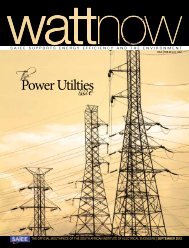download a PDF of the full March 2011 issue - Wattnow
download a PDF of the full March 2011 issue - Wattnow
download a PDF of the full March 2011 issue - Wattnow
- No tags were found...
You also want an ePaper? Increase the reach of your titles
YUMPU automatically turns print PDFs into web optimized ePapers that Google loves.
via conduction in <strong>the</strong> steel. Byraising <strong>the</strong> temperature <strong>of</strong><strong>the</strong> surface sufficiently tocompletely transform <strong>the</strong>microstructure <strong>of</strong> a thinlayer to austenite, and<strong>the</strong>n allowing <strong>the</strong> bulk <strong>of</strong><strong>the</strong> material to conductthat heat away at a sufficientcooling rate, <strong>the</strong> material actsas an effective quenchant so <strong>the</strong> endresult is a layer <strong>of</strong> hardened martensite.Localised heat treatment is <strong>the</strong>reforepossible without burners, furnaces or oilbaths.This process has major advantages whenselected areas need to be hardened withoutaffecting <strong>the</strong> bulk <strong>of</strong> a component: steeringgear assemblies; turbine blades; cut and dyeedges; cam followers; gear teeth; piston rings;plastic injection moulds; cylinder liners for dieselengines; tool steel; bearing surfaces; and shafts.It is an automatic process and <strong>the</strong>refore easily integrated witho<strong>the</strong>r processes on a production line. In comparison to traditionaltechniques, it has quick turnaround times, and it gives an accurateand repeatable depth <strong>of</strong> hardening. It is also possible to achieve 20%higher hardness by using a laser instead <strong>of</strong> traditional quenchingprocesses.Both <strong>the</strong> CSIR’s 5,0kW CO 2laser and its 4,4kW fibre-coupledYAG laser can be used for <strong>the</strong> process: “When using <strong>the</strong> CO 2lasers,with <strong>the</strong>ir longer wavelength, we need to coat <strong>the</strong> surface withgraphite to improve <strong>the</strong> absorption index and <strong>the</strong>refore <strong>the</strong> heattransfer,” explains Theron, “but this is not necessary with <strong>the</strong> YAGlaser.”Two methods are possible: a 12mm single spot method for smallareas; and a scanned track method, which uses a scanning mirrorto sweep <strong>the</strong> laser beam at high speed across <strong>the</strong> hardening path tocreate a rectangular pr<strong>of</strong>ile <strong>of</strong> up to 25mm wide. The technology,while commercially available, is one <strong>of</strong> <strong>the</strong> group’s service <strong>of</strong>ferings:“If you have a requirement, we can assist with process developmentand procurement <strong>of</strong> suitable equipment,” Theron concludes.Corney van Rooyen, an International Welding engineer in <strong>the</strong>Materials Procession group, <strong>the</strong>n presents on his specialist subject,laser cladding. “A focused laser beam creates a shallow weld pooland powdered or wire material is added to that pool to create buildup,” he explains simply. “The process fits nicely between <strong>the</strong> PlasmaTransferred Arc (PTA) cladding and <strong>the</strong> <strong>the</strong>rmal spray processes.Like PTA, though, laser cladding is a fusion process, ie, <strong>the</strong>re isa metallurgical bondbetween <strong>the</strong> workpieceand <strong>the</strong> clad layer.Thermal spraying isa mechanical bondingprocess,” says VanRooyen.Process characteristicsinclude: low heat input, lessthan 0,2kJ/mm, and low dilution,which makes it easier to achieve <strong>the</strong>required surface chemistry in a singlethin layer, typically half a millimetrethick. Highlighting <strong>the</strong> advantages <strong>of</strong><strong>the</strong> process, Van Rooyen tells us aboutits use to repair some stainless watervessels. These vessels had developed StressCorrosion Cracks, which were causing <strong>the</strong>m toleak. The Material Processing group was asked to develop away <strong>of</strong> sealing <strong>the</strong>se cracks from <strong>the</strong> outside without emptying tanks.“It is very difficult to weld a seam that has water squirting out withconventional processes. You end up with porosity,” he explains. “Butby using <strong>the</strong> laser cladding process, even though water was pouringthrough <strong>the</strong> cracks being welded, we were able to contain <strong>the</strong> weldpool and seal <strong>the</strong> cracks without having to drain <strong>the</strong> tanks.”As a result <strong>of</strong> this successful trial, <strong>the</strong> group has now developeda technique for repairing all <strong>of</strong> <strong>the</strong> tanks on site. A containerisedYAG laser will be used, so that <strong>the</strong> laser beam can be transmitted toeach tank via a long fibre-optic conduit, and a mobile space framehas been developed to carry <strong>the</strong> laser welding head along <strong>the</strong> paths<strong>of</strong> <strong>the</strong> cracks.According to Van Rooyen, laser cladding <strong>of</strong>fers excellent processcontrol: low heat input; low energy per unit length; low dilution;high repeatability; and high precision. It can be used to deposit veryaccurate layer thicknesses in a wide range <strong>of</strong> corrosion and wearresistantmaterials.The highlight <strong>of</strong> <strong>the</strong> day was <strong>the</strong> presentation by <strong>the</strong> group’sresearch group leader, Herman Burger, on additive manufacturing.Laser enabled additive manufacturing, Burger believes, “gives aglimpse <strong>of</strong> <strong>the</strong> future and perhaps into <strong>the</strong> future <strong>of</strong> manufacturingin general.”Normal machining processes are subtractive in nature, ie,components are manufactured by removing material using a cuttingtool until <strong>the</strong> part is <strong>the</strong> size and shape required. In contrast, withadditive manufacturing “you start <strong>of</strong>f with nothing and you build<strong>the</strong> part layer by layer – and magic is revealed when you introducea laser into this process.” It allows precise fusing <strong>of</strong> powder ontoprevious layers until <strong>the</strong> finished geometry is realised. By dividing <strong>the</strong>34


